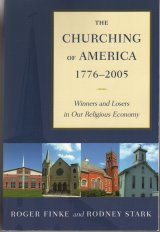Home
The current, official version of this blog is located at christianunityblog.net. For now, I am keeping this copy of the site online also, since so many google searches land here.

Winners and Losers in Our Religious Economy
by Roger Fink and Rodney Stark
Where do our modern churches come from? How did we get here? And what can we learn from that, to help us move forward? These are crucial questions for the church today. The Churching of America (1776-2005) is a great place to gain insights into these questions.
From the very opening page, this book challenges conventional wisdom:
The most striking trend in the history of religion in America is its growth--or what we call the churching of America. The backbone of this book consists of our attempt to explore and explain how and why America shifted from a nation in which most people took no part in organized religionto a nation in which nearly two-thirds of American adults do. ...Not all denominations shared in the immense rise in membership rates, and to the degree that denominations rejected traditional doctrines and ceased to make serious demands on their followers, they ceased to prosper. The churching of America was accomplished by aggressive churches committed to vivid otherworldliness.The first chapter of the book discusses the methodology of the writers in their investigation into the patterns of church growth in America, and for the causes of those patterns. They viewed the religious environment as a kind of economy, where different denominations compete with their ideas and methods for followers. In the subsequent chapters, they traced not merely the number of adherents in various denominations, but also their market share (percentage of the "churched" population) and market penetration (percentage of the total population). They traced church growth in America, starting in the year 1776, when 17% of the population were members of a church, through the year 2005, when 62% of the population were church members. And in the midst of that dramatic growth, they examined the meteoric rise of particular denominations, and the severe decline of others.
The authors traced the fortunes of the Congregationalists, Episcopals, Presbyterians, Methodists, Baptists, and Catholics starting from colonial days---the decline in market share of the first three, and the gains in the latter three. In particular, the Methodists experienced breathtaking growth, from a 2.5% market share in 1776, to an amazing 34.2% by 1850. That gain in market share is all the more impressive when one considers that the market itself grew in size during those years.
In 1776 the Methodists were a tiny religious society with only 65 churches scattered throughout the colonies. In 1850 there were 13,302 Methodist congregations, enrolling more than 2.6 million members -- the largest single denomination, accounting for more than a third of American church members.The Methodists won America during those years through hard work and a simple, passionate message. The trend started with the revolutionary effect of the great George Whitefield, preaching to tens of thousands at a time and converting thousands. Following Whitefield came a cavalry of circuit riders, men who spent their lives riding on horseback from village to village, holding large evangelistic camp meetings, building and strengthening churches. The message was sin, repentance, and judgment. The congregations were organized into small groups called classes, consisting of a dozen or so people under the care of a class leader. Several of these classes would form a congregation. The preacher of the congregation, more often than not, was a farmer like the the rest of the congregation, receiving little or no pay for his role as minister.
As the Methodists rose, the Congregationalists declined. The decline was not obvious at first because, while they were clearly losing market share, their numbers were growing because the overall population was growing rapidly. But under the liberal influence of their universities (including Harvard and Yale), they were leaving behind many basic convictions about the nature of God and his relationship to man. Humanism and Deism crept in, and the message became ever less compelling. The Methodists, with their passionate plea for repentance and warnings of judgment to come, ate the Congregationalists' lunch.
After 1850, the Methodists entered their own decline. They had acquired nice buildings and were beginning to employ a university-educated clergy. Their message became diluted and other upstart groups began to take away their market share.
The authors trace a similar pattern through several other religous groups. They identified a common thread distinguishing the winners and the losers. They described a continuum extending from "sects" to "churches". They used the term "sect" to identify religious groups that exist in strong tension with the culture around them. Sects expect a lot from their members. There is a high cost and a high reward for membership. On the other end of the continuum, the authors applied the term "church" to those religious groups that blend into their culture. For these groups, the cost of membership was not high, and the reward was correspondingly low. The consistent pattern seen in this book is that the sects beat the churches every time. As churches go into decline, sects enter the vacuum and thrive. Thus the overall religious adherence in America has risen steadily for over 200 years, despite the severe decline of many prominent religious groups.
This is a fascinating book for anyone interested in learning lessons from church history. As the saying goes, those who fail to learn from history are destined to repeat it.
Labels: Book Review
Certainly some formerly prominent denominations drifted from their roots and went into decline -- first the Congregationalists, later the Methodists. But whenever that happened to one denomination, an upstart came in and "ate their lunch." The theme of the book is that there have always been fast growing upstart churches that preached an other-worldly, set apart message. The large prominent denominations have tended to became like the culture around them, and then drift into insignificance. And the upstarts rose from their ashes.
Links to this post:
<< Home



